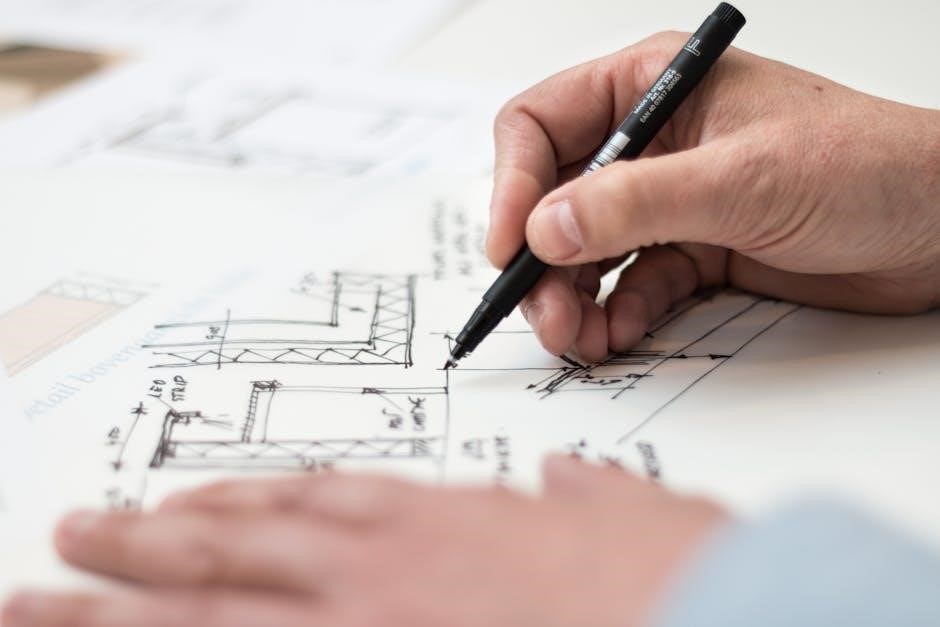Drafting instructions provide guidelines for creating documents‚ using
specific
formats and structures to communicate effectively‚ with clear and concise language‚ in thirty-three words maximum always.
Definition of Drafting Instructions
Drafting instructions are guidelines that outline the process of creating documents‚ including the structure‚ format‚ and language to be used. These instructions are typically provided to ensure consistency and clarity in the documents produced. The definition of drafting instructions can vary depending on the context‚ but generally‚ they refer to the rules and guidelines that govern the creation of documents. In the context of law‚ drafting instructions are used to communicate policy objectives and guide the development of laws and regulations. They provide a framework for drafting documents‚ including the use of specific language‚ formatting‚ and structure. By following drafting instructions‚ individuals can create high-quality documents that effectively communicate their message. Overall‚ drafting instructions play a crucial role in ensuring that documents are well-structured‚ clear‚ and concise‚ and that they achieve their intended purpose. They are an essential tool for effective communication.
Importance of Drafting Standards
Drafting standards are essential for ensuring that documents are consistent‚ clear‚ and concise. The use of standard drafting practices helps to prevent errors and ambiguities‚ and ensures that documents are easily understood by their intended audience. By following established drafting standards‚ individuals can create high-quality documents that are free from confusion and misinterpretation. This is particularly important in legal and technical contexts‚ where the accuracy and clarity of documents can have significant consequences. The importance of drafting standards cannot be overstated‚ as they provide a framework for creating documents that are effective‚ efficient‚ and easy to use. By adhering to established standards‚ individuals can ensure that their documents are professional‚ polished‚ and effective in communicating their intended message. Overall‚ drafting standards are a critical component of effective document creation. They help to ensure that documents are well-structured and easy to understand.

Architectural Drafting
Architectural drafting involves creating pictorial images of buildings using various media and techniques‚ following specific guidelines and standards always‚ with precision and accuracy‚ in thirty-three words.
Overview of Architectural Drafting
Architectural drafting is a process of creating detailed drawings and plans of buildings and structures‚ using various techniques and tools‚ including manual drafting and computer-aided design. The goal of architectural drafting is to produce accurate and detailed drawings that can be used to construct buildings and other structures. This involves creating floor plans‚ elevations‚ and cross-sections of buildings‚ as well as detailing the various components and systems that make up the building. Architectural drafting requires a strong understanding of building design‚ construction methods‚ and materials‚ as well as the ability to communicate effectively through drawings and other visual means. By using a combination of art and science‚ architectural drafters can create detailed and accurate drawings that bring building designs to life‚ and help to ensure that buildings are safe‚ functional‚ and aesthetically pleasing. The process involves several steps and requires great attention to detail.
Types of Drafting Media
Drafting media refers to the materials used to create drawings and plans‚ including papers and films. The choice of drafting media depends on the specific requirements of the project‚ such as the level of detail and the desired finish. Traditional drafting media includes graph paper‚ tracing paper‚ and vellum‚ while modern drafting media includes computer-aided design software and digital drawing tools. Other types of drafting media include sketching paper‚ illustration board‚ and drafting film‚ each with its own unique characteristics and uses. The selection of drafting media is an important consideration in the drafting process‚ as it can affect the quality and accuracy of the final product. By choosing the right drafting media‚ drafters can ensure that their drawings are clear‚ concise‚ and effective in communicating their ideas. Different media have different advantages and disadvantages‚ and drafters must be familiar with them.

Computer-Aided Drafting
Computer-aided drafting uses software to create precise drawings and models‚ enhancing productivity and accuracy always‚ with specific tools and techniques‚ in thirty-three words maximum always.
CAD Drafting Standards and Procedures

CAD drafting standards and procedures are essential for creating consistent and accurate drawings.
These standards include guidelines for layering‚ dimensioning‚ and annotation‚ ensuring that all drawings are clear and easily understandable.
The use of CAD software enables drafters to create precise and detailed drawings‚ which can be easily modified and updated.
A well-structured CAD system is crucial for efficient drafting‚ and it involves organizing files‚ setting up templates‚ and establishing workflows.
By following CAD drafting standards and procedures‚ drafters can produce high-quality drawings that meet industry requirements and client expectations.
Effective CAD management is critical for successful drafting‚ and it involves regular software updates‚ training‚ and technical support.
Overall‚ CAD drafting standards and procedures play a vital role in the drafting process‚ enabling drafters to create accurate and professional drawings.
This helps to ensure that drafting projects are completed efficiently and effectively‚ with minimal errors or delays.
Revision History and Quality Procedures
Revision history is a record of changes made to a document or drawing‚ including the date‚ time‚ and description of each revision.
Quality procedures are essential for ensuring that drafting instructions are accurate‚ complete‚ and consistent.
A well-documented revision history helps to track changes and maintain the integrity of the drafting process.
Quality procedures involve regular reviews and updates of drafting standards and guidelines.
This ensures that drafting instructions are aligned with industry best practices and regulatory requirements.
Effective quality procedures also involve training and certification programs for drafters.
By following established quality procedures‚ drafters can ensure that their work meets the required standards.
Revision history and quality procedures are critical components of the drafting process‚ enabling drafters to produce high-quality documents and drawings.
These procedures help to minimize errors and ensure that drafting instructions are clear‚ concise‚ and easy to follow.

Document Drafting Handbook
The handbook provides guidance on drafting documents‚ including formatting and style‚ using specific templates and guidelines always and correctly online.
Purpose of the Document Drafting Handbook
The purpose of the document drafting handbook is to provide guidance on drafting documents‚ including formatting and style‚ using specific templates and guidelines. The handbook is intended to assist in creating clear and concise documents‚ with a focus on effective communication; It outlines the procedures for drafting‚ reviewing‚ and revising documents‚ ensuring that they meet the required standards. The handbook also provides information on the use of language‚ tone‚ and terminology‚ as well as the importance of accuracy and consistency. By following the guidelines outlined in the handbook‚ users can create high-quality documents that are easy to understand and use. The handbook is a valuable resource for anyone involved in drafting documents‚ and is an essential tool for ensuring that documents are drafted to a high standard‚ with attention to detail and clarity. This is crucial for effective communication.
Applicability of the Document Drafting Handbook
The document drafting handbook is applicable to all documents‚ regardless of their purpose or audience. It provides a set of guidelines and standards that can be applied to any type of document‚ from reports and proposals to policies and procedures. The handbook is intended to be used by anyone involved in drafting documents‚ including writers‚ editors‚ and reviewers. It is also relevant to individuals who need to create documents as part of their job or studies. The handbook’s applicability is not limited to specific industries or sectors‚ but rather can be applied universally. By following the guidelines outlined in the handbook‚ users can ensure that their documents are well-structured‚ clear‚ and concise‚ and that they meet the required standards. This helps to promote effective communication and consistency in document drafting. The handbook is a valuable resource for anyone involved in document creation.
